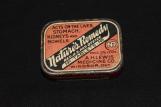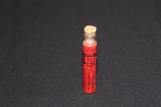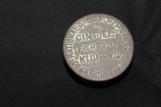1
At the turn of the twentieth century, New Brunswick was home to a medical marketplace that was democratic, largely unregulated, pluralistic in character. On the front lines of healthcare were women, who treated most diseases and injury that befell their families with dedicated care, drawing from longstanding folk traditions, or a wide variety of "home-care manuals" to guide their care. Midwives, trained through apprenticeship, delivered most of the babies, and by extension also treated the diseases of women, children, or whole families as the need arose. As the century unfolded many women sought formal nursing training, and returned to rural New Brunswick to combine the roles of "nurse-midwife," and provide what we would now call "primary care" to their communities.2
ENO "Fruit Salt"1880-1950
Fredericton, New Brunswick, Canada
 Credits:
Credits:York Sunbury Historical Society Collection 2012.7.7
3
Nature's Remedy20th Century, Circa 1922
Fredericton, New Brunswick, Canada
 Credits:
Credits:York Sunbury Historical Society collection 2012.6.4
4
'Regular' physicians shared the medical marketplace with a variety of herbalists and faith healers who moved from place to place plying their medical trade or dispensing patent medicines to patrons. New Brunswick was also home to some sectarian practitioners, who engaged practices as homeopaths, osteopaths, and chiropractors. It was not uncommon to find barbers practicing the ancient art of phlebotomy ("bleeding" their clients) as a health maintenance regime. The health economy was also populated with less familiar sects: for instance, Thomsonians (who relied on the therapeutic benefits of the lobelia plant), and Eclectics (who, as their name suggests, favoured sampling from a variety of therapeutic approaches) were uncommon in New Brunswick, although they were far more populous south of the border in the United States.5
Carter's Little Liver Pills20th Century, Circa 1930
Fredericton, New Brunswick, Canada
 Credits:
Credits:York Sunbury Historical Society Collection 2012.6.6
6
Rawleigh's Quinine Bromide Laxative Cold TabletsEarly 20th Century, Circa 1920
Fredericton, New Brunswick, Canada
 Credits:
Credits:2012.6.2 - York Sunbury Historical Society Collection
7
For minor medical problems and for those who could not afford access to a doctor there was a wide range of non-prescription medicines available in the early twentieth century. Such medicines cured a wide range of symptoms all at once. "Carter's Little Liver Pills" were popular throughout the first half of the twentieth century and advertisements in newspapers claimed that they could cure constipation, biliousness, sick headache and indigestion as well as eliminate bile and help improve the complexion. This was not the only medicine used to treat a number of symptoms and illnesses, glycerine was used as a topical agent to treat minor cuts and burns, as well as to help hydrate skin and improve sallow skin complexion. Many of these products were made of general herbal remedies such as from juniper berries in the case of gin pills that were used to treat all matters of issues with kidneys.8
Gin Pills for the Kidneys1920-1930
Fredericton, New Brunswick, Canada
 Credits:
Credits:1972.7.58 - York Sunbury Historical Society Collection
9
Glycerine Bottle1910-1960
Fredericton, New Brunswick, Canada
 Credits:
Credits:York Sunbury Historical Society collection 2008.19.9
10
Bronchalent1910-1960
Fredericton, New Brunswick, Canada
 Credits:
Credits:2012.7.2 - York Sunbury Historical Society Collection
11
ReferencesYork Sunbury Historical Society. "From Black Bag to High Science." Officers' Quarters 28 no.2, Special Exhibits Edition (2011).